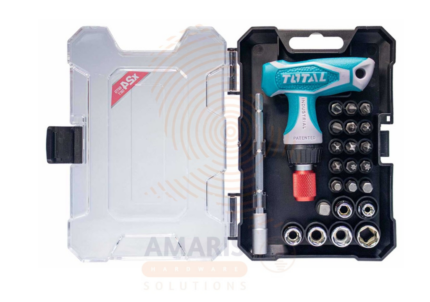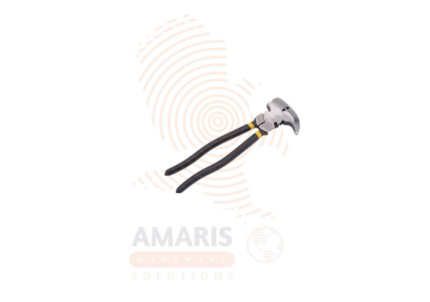Tap and Die Set
$76.92 Original price was: $76.92.$73.07Current price is: $73.07.
A tap and die set is a collection of tools designed for threading and cutting threads on screws, bolts, and other fasteners. The set typically includes various sizes of taps and dies, which are used for creating or repairing threads on metal surfaces. Taps are used to cut internal threads, while dies are used for cutting external threads.
A 32-piece set implies that it contains 32 individual tools, which may include both taps and dies in different sizes. The sizes can vary to accommodate a range of thread specifications commonly found in mechanical and automotive applications. These sets are useful for machinists, mechanics, or anyone involved in metalworking who needs to create or repair threads in various sizes and diameters. The set may also come with a case for organization and storage, making it a convenient and versatile tool kit for threading tasks.
Table of Contents
ToggleTap and Die Set
Uses
-
Thread Cutting and Repair: The primary purpose of a tap and die set is to cut or repair threads on screws, bolts, and other fasteners. This is essential for creating secure and functional connections between metal components.
-
Automotive Repairs: Mechanics often use tap and die sets to repair or create threads on automotive parts, such as engine components, exhaust systems, and suspension parts.
-
Machinery Maintenance: In industrial settings, tap and die sets are frequently used for maintenance and repair of machinery. This includes creating or restoring threads on bolts, screws, and other components.
-
Metal Fabrication: Metalworkers and fabricators use tap and die sets to customize fasteners for specific projects. This is common in constructing metal structures, equipment, and other fabricated items.
-
DIY and Home Repairs: Hobbyists, DIY enthusiasts, and homeowners can use tap and die sets for various tasks around the house. This may include repairing bicycles, lawnmowers, furniture, or other items with threaded connections.
-
Plumbing Repairs: Tap and die sets can be used to repair or create threads on pipes and fittings, making them useful for plumbing repairs and installations.
-
Tool and Equipment Customization: Machinists and toolmakers use tap and die sets to customize tools and equipment by creating or modifying threads on handles, bolts, and other components.
-
Aerospace Applications: In the aerospace industry, tap and die sets are used for precision work on aircraft components, ensuring that threaded connections meet strict specifications.
-
Electronics Manufacturing: Tap and die sets are employed in manufacturing electronic devices and equipment, where precision and reliability in threaded connections are crucial.
-
Jewelry Making: In smaller scale applications, jewelers may use tap and die sets for creating custom threaded connections in jewelry components.
Safety Precautions
-
Eye Protection:
-
Always wear safety glasses or goggles to protect your eyes from metal shavings, debris, or any potential flying particles during the tapping and threading process.
-
-
Hand Protection:
-
Wear gloves to protect your hands from sharp edges, especially when handling metal pieces or working with cutting tools.
-
-
Work Area Safety:
-
Keep your work area clean and well-lit. Make sure there are no tripping hazards, and organize tools to minimize the risk of accidents.
-
-
Stable Work Surface:
-
Use a stable and secure workbench or work surface to prevent slips, trips, or other accidents. Ensure that the workpiece is securely clamped in place.
-
-
Proper Tool Selection:
-
Select the appropriate tap and die for the job. Using the wrong size or type of tool can lead to damage, breakage, or improper threading.
-
-
Tool Inspection:
-
Before use, inspect taps and dies for any damage, wear, or defects. Damaged tools can be unsafe and may result in poor quality threads or accidents.
-
-
Secure Holding:
-
Ensure that the workpiece is securely held in place with clamps or a vise. This prevents unexpected movement and helps maintain control during the threading process.
-
-
Correct Technique:
-
Follow proper tapping and threading techniques. Apply steady and even pressure, and avoid excessive force that could lead to tool breakage or injury.
-
-
Cutting Fluid:
-
Use cutting fluid or lubricant when tapping to reduce friction, heat, and wear on the tools. This helps in achieving cleaner threads and prolonging the life of the taps and dies.
-
-
Mindful Handling:
-
Handle the taps and dies with care. Avoid dropping them, and be cautious when working with sharp edges.
-
-
Emergency Preparedness:
-
Know the location of emergency equipment, such as a first aid kit or fire extinguisher, in case of an accident. Ensure that you have easy access to emergency contact information.
-
-
Training and Knowledge:
-
Make sure you are familiar with the proper use of tap and die tools. If you are new to using these tools, seek guidance from experienced individuals or undergo proper training.
-
-
Personal Protective Equipment (PPE):
-
Depending on the specific task and environment, consider using additional personal protective equipment such as hearing protection if working in a noisy environment.
-


 Acrylic Sealants
Acrylic Sealants Construction Adhesives
Construction Adhesives Double-Sided Tape
Double-Sided Tape Duct Tape
Duct Tape Electrical Tape
Electrical Tape Epoxy & Resins
Epoxy & Resins Masking Tape
Masking Tape
 Automotive Wrenches & Socket Sets
Automotive Wrenches & Socket Sets Battery Chargers & Jump Starters
Battery Chargers & Jump Starters Car Jacks & Stands
Car Jacks & Stands Car Wash & Detailing Products
Car Wash & Detailing Products Diagnostic Tools
Diagnostic Tools Tire Inflators
Tire Inflators Vehicle Lighting
Vehicle Lighting Oil & Lubricants
Oil & Lubricants
 Adhesives & Sealants
Adhesives & Sealants Bricks & Blocks
Bricks & Blocks Cement & Concrete
Cement & Concrete Drywall & Plaster
Drywall & Plaster Flooring (Tiles, Wood, Laminate)
Flooring (Tiles, Wood, Laminate) Lumber & Plywood
Lumber & Plywood Paints, Primers & Coatings
Paints, Primers & Coatings Insulation Materials
Insulation Materials Roofing Materials
Roofing Materials
 Circuit Breakers
Circuit Breakers Electrical Cables & Wires
Electrical Cables & Wires Switches & Sockets
Switches & Sockets Fuses & Relays
Fuses & Relays Connectors & Terminals
Connectors & Terminals Electrical Boxes & Panels
Electrical Boxes & Panels Conduit & Fittings
Conduit & Fittings Lighting Fixtures & Bulbs
Lighting Fixtures & Bulbs Extension Cords & Power Strips
Extension Cords & Power Strips
 Anchors
Anchors Bolts
Bolts Clips & Clamps
Clips & Clamps Screws
Screws Nuts
Nuts Washers
Washers Rivets
Rivets Nails
Nails Threaded Rods
Threaded Rods
 Hammers
Hammers Measuring Tools (Tapes, Levels, Calipers)
Measuring Tools (Tapes, Levels, Calipers) Screwdrivers
Screwdrivers Pliers & Cutters
Pliers & Cutters Saws & Blades
Saws & Blades Chisels & Punches
Chisels & Punches Allen Keys & Hex Keys
Allen Keys & Hex Keys Ratchets & Socket Sets
Ratchets & Socket Sets Wrenches & Spanners
Wrenches & Spanners
 Power Tool Accessories (Blades, Bits, Discs)
Power Tool Accessories (Blades, Bits, Discs) Rotary Tools
Rotary Tools Saws (Circular, Jigsaw, Reciprocating)
Saws (Circular, Jigsaw, Reciprocating) Drills & Drivers
Drills & Drivers Grinders & Sanders
Grinders & Sanders Heat Guns
Heat Guns Nail Guns
Nail Guns Impact Wrenches
Impact Wrenches Batteries & Chargers
Batteries & Chargers
 Pipes & Fittings (PVC, Copper, PEX)
Pipes & Fittings (PVC, Copper, PEX) Plumbing Tools
Plumbing Tools Pumps & Motors
Pumps & Motors Sealants & Adhesives for Plumbing
Sealants & Adhesives for Plumbing Valves & Taps
Valves & Taps Water Heaters
Water Heaters Drainage Systems
Drainage Systems Faucets & Fixtures
Faucets & Fixtures Hoses & Tubing
Hoses & Tubing
 Hinges & Latches
Hinges & Latches Hooks & Brackets
Hooks & Brackets Window Hardware
Window Hardware Chains & Cables
Chains & Cables Casters & Wheels
Casters & Wheels Shelving & Storage Systems
Shelving & Storage Systems Door Handles & Locks
Door Handles & Locks Drawer Slides & Cabinet Hardware
Drawer Slides & Cabinet Hardware
 Personal Protective Equipment (PPE)
Personal Protective Equipment (PPE) Respirators & Masks
Respirators & Masks Safety Glasses
Safety Glasses Safes
Safes Security Cameras
Security Cameras Gloves
Gloves Helmets
Helmets Ear Protection
Ear Protection Fire Safety Equipment
Fire Safety Equipment Locks & Padlocks
Locks & Padlocks Motion Sensors & Alarms
Motion Sensors & Alarms
 Garden Fencing
Garden Fencing Garden Furniture Hardware
Garden Furniture Hardware Lawn Mowers
Lawn Mowers Trimmers & Edgers
Trimmers & Edgers Shovels & Spades
Shovels & Spades Rakes & Hoes
Rakes & Hoes Pruning Shears & Loppers
Pruning Shears & Loppers Watering Systems (Hoses, Sprinklers, Nozzles)
Watering Systems (Hoses, Sprinklers, Nozzles)
 Interior Paints
Interior Paints Paint Brushes & Rollers
Paint Brushes & Rollers Paint Strippers & Thinners
Paint Strippers & Thinners Paint Trays & Accessories
Paint Trays & Accessories Exterior Paints
Exterior Paints Spray Paints
Spray Paints Primers & Undercoats
Primers & Undercoats Varnishes & Stains
Varnishes & Stains
 Gaskets & Seals
Gaskets & Seals Hydraulic Fittings
Hydraulic Fittings Industrial Fasteners
Industrial Fasteners Industrial Hoses
Industrial Hoses Lubricants & Greases
Lubricants & Greases Metal Sheets & Bars
Metal Sheets & Bars Bearings & Bushings
Bearings & Bushings Belts & Pulleys
Belts & Pulleys
 HVAC Filters
HVAC Filters Insulation for HVAC
Insulation for HVAC Air Conditioners
Air Conditioners Refrigerants
Refrigerants Ventilation Ducts & Fittings
Ventilation Ducts & Fittings Thermostats & Controllers
Thermostats & Controllers Fans & Blowers
Fans & Blowers
 Pegboards & Hooks
Pegboards & Hooks Shelving Units
Shelving Units Storage Bins & Containers
Storage Bins & Containers Toolboxes & Tool Chests
Toolboxes & Tool Chests Workbenches
Workbenches Drawer Organizers
Drawer Organizers Labeling Supplies
Labeling Supplies
 Welding Accessories (Clamps, Brushes)
Welding Accessories (Clamps, Brushes) Welding Electrodes & Rods
Welding Electrodes & Rods Welding Helmets & Gloves
Welding Helmets & Gloves Welding Machines
Welding Machines Soldering Irons & Stations
Soldering Irons & Stations Flux & Solder Wire
Flux & Solder Wire
 Generator Accessories
Generator Accessories Inverters
Inverters Portable Generators
Portable Generators Power Inverters
Power Inverters Transfer Switches
Transfer Switches Diesel & Gasoline Generators
Diesel & Gasoline Generators
 Transport Equipment: Carts, Dollies, and Hand Trucks
Transport Equipment: Carts, Dollies, and Hand Trucks Storage Solutions: Pallets, Racks, and Containers
Storage Solutions: Pallets, Racks, and Containers Lifting Equipment: Hoists, Cranes, and Jacks
Lifting Equipment: Hoists, Cranes, and Jacks Conveyors and Accessories: Belts and Rollers
Conveyors and Accessories: Belts and Rollers











